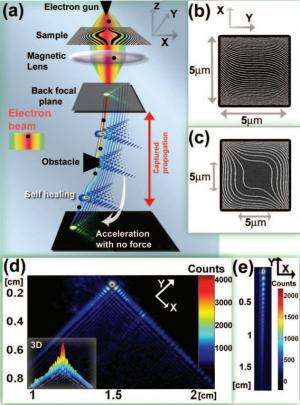February 22, 2013 report
Researchers discover a way to generate an electron Airy beam

(Phys.org)—A team of physicists in Israel has succeeded in generating an electron Airy beam for the first time. As they describe in their paper published in the journal Nature, the researchers used a technique similar to that used by previous researchers to create Airy beams based on light.
As most people are aware, light tends to travel in a straight line, though when it's sent through an aperture, such as is done with a common flashlight, diffraction occurs, causing the beam to widen and lose its intensity. In certain instances, however, light can be made to traverse an arced path instead of a straight line if its waveform is shaped in a certain way. Such beams are known as Airy beams, after Sir George Biddell Airy who developed a function that describes such arcs while studying the light properties of rainbows—researchers in 2007 discovered a way to actually create Airy beams based on light. Now, a research team from Israel has found a way to create the same types of beams using electrons instead of light.
Per quantum physics, waves and particles are characteristics of the same scheme, and a particle's trajectory is determined by its waveform which gives rise to the probability that a given particle may be discovered at a particular place. When waves move through an opening, however, such as with a laser, they interfere with one another—each has their path disturbed—resulting in diffraction. If the waveform is manipulated though, the wave can be caused to follow a curved path and because it applies to the entire wave function, no diffraction occurs. This means that in addition to tracing arced trajectories, Airy beams also retain their intensity over long distances.
To generate an Airy beam using electrons, the team massaged the wave function of an electron beam by shooting it through a specially designed hologram—its pattern was designed specifically to cause the desired result. The beam was focused by a magnetic field—it caused a triangularly shaped bundle of beams to form, each of which followed an arced path. In studying the beams produced, the researchers also found that electron Airy beams were able to "heal" themselves if they ran into an object, such as a glass wire—reforming on the other side.
This new research is likely to prove useful in developing better tunneling electron microscopes, or in research focused on what happens with electrons when traveling over long distances.
More information: Generation of electron Airy beams, Nature 494, 331–335 (21 February 2013) doi:10.1038/nature11840
Abstract
Within the framework of quantum mechanics, a unique particle wave packet exists in the form of the Airy function. Its counterintuitive properties are revealed as it propagates in time or space: the quantum probability wave packet preserves its shape despite dispersion or diffraction and propagates along a parabolic caustic trajectory, even though no force is applied. This does not contradict Newton's laws of motion, because the wave packet centroid propagates along a straight line. Nearly 30 years later, this wave packet, known as an accelerating Airy beam, was realized in the optical domain; later it was generalized to an orthogonal and complete family of beams that propagate along parabolic trajectories, as well as to beams that propagate along arbitrary convex trajectories. Here we report the experimental generation and observation of the Airy beams of free electrons. These electron Airy beams were generated by diffraction of electrons through a nanoscale hologram, which imprinted on the electrons' wavefunction a cubic phase modulation in the transverse plane. The highest-intensity lobes of the generated beams indeed followed parabolic trajectories. We directly observed a non-spreading electron wavefunction that self-heals, restoring its original shape after passing an obstacle. This holographic generation of electron Airy beams opens up new avenues for steering electronic wave packets like their photonic counterparts, because the wave packets can be imprinted with arbitrary shapes or trajectories.
See also: Self accelerating electron Airy beams, arXiv:1205.2112 [physics.optics] arxiv.org/abs/1205.2112
Journal information: Nature
© 2013 Phys.org



















